Designing Geographic Information System Based Property Tax Assessment in India
Abstract
:1. Introduction
2. Materials and Methods
2.1. Study Area
2.2. Methods
3. Results and Discussion
3.1. Geodatabase of the Implementing the Property Tax
3.2. Property Tax Implementation
3.3. Mapping of Taxpayers Data
4. Conclusions
Author Contributions
Funding
Data Availability Statement
Acknowledgments
Conflicts of Interest
References
- Eckert, J.K.; Goudemans, R.J.; Almy, R.R. Properp Appraisal and Assessment Administration; The International Association of Assessing Otlicers: Kansas City, MO, USA, 1990; p. 6. [Google Scholar]
- Dillinger, W. Urban Property Tax Reform: Guidelines and Recommendations. World Bank Urban Management Program Tool #1; World Bank: Washington, DC, USA, 1991. [Google Scholar]
- Bahl, R.; Linn, J. Urban Public Finance in Developing Countries; Oxford University Press: New York, NY, USA, 1992. [Google Scholar]
- Bahl, R. Implementation Rules for Fiscal Decentralization. Paper Presented at the International Seminar on Land Policy and Economic Development, Land Reform Training Institute, Taoyuan City, Taiwan, 17 November 1998; International Studies Program, School of Policy Studies, Georgia State University: Atlanta, GA, USA, 1999. [Google Scholar]
- Corker, L.; Nieminen, J. Improving Municipal Cash Flow—Systematic Land Information Management. In Proceedings of the International Conference on Spatial Information and Sustainable Development, TS 6.1 Economic Values, Nairobi, Kenya, 2–5 October 2001; pp. 1–12. [Google Scholar]
- Soeb, P.; Zahari, W.; David, M.; Fazira, S. Property Tax Management Model of Local Authorities in Malaysia Soeb Pawi. Chinese Bus. Rev. 2011, 10, 1–12. [Google Scholar]
- Kundu, D.; Ghosh, D. Innovations in property taxation systems in India. In Innovative Land and Property Taxation; Sietchiping, R., Ed.; UN-Habitat: Nairobi, Kenya, 2011; pp. 92–109. ISBN 978-92-1-132407-5. [Google Scholar]
- National Institute of Urban Affairs (NIUA). Available online: https://www.niua.org/urban-india/urban-india-2010-jan-jun (accessed on 12 December 2021).
- Gupta, R.D.; Garg, P.K.; Arora, M. A GIS Based Decision Support System for Developmental Planning in Dehradun District. J. Indian Cartogr. 2001, 21. [Google Scholar]
- Bell, M.E. An Optimal Property Tax: Concepts and Practices. In Proceedings of the Intergovernmental Fiscal Relations and Local Financial Management, Almaty, Kazakhstan, 17–21 April 2000. [Google Scholar]
- Mathur, O.P.; Thakur, D.; Rajadhyaksha, N.; Bahl, R. Urban Property Tax Potential in India; National Institute of Public Finance and Policy: New Delhi, India, 2009. [Google Scholar]
- Stylianidis, E.; Roustanis, T.; Karanikolas, N. A Geographical Information System for Real Estate (GEOVAL) BT—Location Based Services and TeleCartography II: From Sensor Fusion to Context Models; Gartner, G., Rehrl, K., Eds.; Springer: Berlin/Heidelberg, Germany, 2009; pp. 317–329. ISBN 978-3-540-87393-8. [Google Scholar]
- Arbia, G. Spatial Data Configuration in Statistical Analysis of Regional Economic and Related Problems; Kluwer Academic: Dordrecht, The Netherlans; Boston, MA, USA, 1989; ISBN 0792302842 9780792302841. [Google Scholar]
- Tomlin, C.D. Geographic Information Systems and Cartographic Modeling, 1st ed.; Prentice-Hall, Inc.: Englewood Cliffs, NJ, USA, 1990; ISBN 0-13-350927-3. [Google Scholar]
- Huxold, W.E. An Introduction to Urban Geographic Information Systems; Oxford University Press: New York, NY, USA, 1991; ISBN 9780195065343. [Google Scholar]
- Star, J.; Estes, J. Geographic information systems: An introduction. Geocarto Int. 1991, 6, 46. [Google Scholar] [CrossRef]
- Aronoff, S. Geographic information systems: A management perspective. Geocarto Int. 1989, 4, 58. [Google Scholar] [CrossRef]
- Fedosin, S.; Yamashkin, S.A. Technological process of solving the problem of modeling the structure of land use based on remote sensing data. Sci. Tech. Bull. Volga Reg. 2014, 6, 356–359. [Google Scholar]
- Farooqi, S.A.; Gazali, S. Application of Geographical Information System in Urban Management and Planning: A Case Study of Kulgaon-Badlapur, Dist-Thane, Maharashtra. Int. J. Adv. Remote Sens. GIS 2014, 3, 476–485. [Google Scholar]
- Bandyopadhyay, S. Property Tax Reforms in India: A Comparison of Delhi and Bangalore; Georgia State University: Atlanta, GA, USA, 2013. [Google Scholar]
- Samadzadegan, F.; Alvand, A.; Abootalebi, A.; Hasanlou, M. Enterprise GIS For Municipalities—A Service Oriented Approach. In Proceedings of the The International Archives of the Photogrammetry, Remote Sensing and Spatial Information Sciences; Leibniz University Hannover Institute of Photogrammetry and GeoInformation: Hannover, Germany, 2008; pp. 1133–1136. [Google Scholar]
- Idrizi, B.; Sulejmani, V.; Zimeri, Z. Multi-Scale Map for Three Levels of Spatial Planning Data Sets for the Municipality of Vitia in Kosova. In Proceedings of the 7th International Conference on Cartography and GIS, Sozopol, Bulgaria, 18–23 June 2018. [Google Scholar]
- Krishna, G.; Biradar, C. Geo-Big Data in Digital Augmentation and Accelerating Sustainable Agroecosystems. In Data Science in Agriculture and Natural Resource Management; Springer: Singapore, 2022; pp. 221–242. [Google Scholar]
- Sibilla, M.; Abanda, F.H. Multi-Criteria Decision Making Optimisation Framework for Positive Energy Blocks for Cities. Sustainability 2022, 14, 446. [Google Scholar] [CrossRef]
- Olawumi, T.O.; Chan, D.W. Cloud-based sustainability assessment (CSA) system for automating the sustainability decision-making process of built assets. Expert Syst. Appl. 2022, 188, 116020. [Google Scholar] [CrossRef]
- Ahansal, Y.; Bouziani, M.; Yaagoubi, R.; Sebari, I.; Sebari, K.; Kenny, L. Towards Smart Irrigation: A Literature Review on the Use of Geospatial Technologies and Machine Learning in the Management of Water Resources in Arboriculture. Agronomy 2022, 12, 297. [Google Scholar] [CrossRef]
- El Hoummaidi, L.A.L.A.; Larabi, A. Dubai Smart Map, A New Tool Enabling Geo-Digital Government, Driven By Innovative Geospatial Thinking For A Smart And Sustainable Dubai. Int. J. Civ. Struct. Environ. Infrastruct. Eng. Res. Dev. 2019, 9, 17–36. [Google Scholar]
- Ujjwal, K.C.; Garg, S.; Hilton, J.; Aryal, J.; Forbes-Smith, N. Cloud Computing in natural hazard modeling systems: Current research trends and future directions. Int. J. Disaster Risk Reduct. 2019, 38, 101188. [Google Scholar]
- Pretorius, R.W.; Carow, S.; Wilson, G.; Schmitz, P. Using real-world engagements for sustainability learning in ODeL in the Global South: Challenges and opportunities. Int. J. Sustain. High. Educ. 2021, 21, 1316–1335. [Google Scholar] [CrossRef]
- Shah, P. IGiS for Managing Cities Smartly–Urban Geoinformatics. Int. Arch. Photogramm. Remote Sens. Spat. Inf. Sci. 2021, 46, 509–513. [Google Scholar] [CrossRef]
- Rowland, A.; Folmer, E.; Beek, W. Towards Self-Service GIS—Combining the Best of the Semantic Web and Web GIS. ISPRS Int. J. Geo-Inf. 2020, 9, 753. [Google Scholar] [CrossRef]
- Miloudi, L.; Rezeg, K. Leveraging the power of integrated solutions of IoT and GIS. In Proceedings of the 2018 3rd International Conference on Pattern Analysis and Intelligent Systems (PAIS), Tebessa, Algeria, 24–25 October 2018; pp. 1–7. [Google Scholar]
- Meraj, G.; Kanga, S.; Kranjčić, N.; Đurin, B.; Singh, S.K. Role of natural capital economics for sustainable management of earth resources. Earth 2021, 2, 622–634. [Google Scholar] [CrossRef]
- Shyam, M.; Meraj, G.; Kanga, S.; Farooq, M.; Singh, S.K.; Sahu, N.; Kumar, P. Assessing the Groundwater Reserves of the Udaipur District, Aravalli Range, India, Using Geospatial Techniques. Water 2022, 14, 648. [Google Scholar] [CrossRef]
- Kanga, S.; Singh, S.K.; Meraj, G.; Kumar, A.; Parveen, R.; Kranjčić, N.; Đurin, B. Assessment of the Impact of Urbanization on Geoenvironmental Settings Using Geospatial Techniques: A Study of Panchkula District, Haryana. Geographies 2022, 2, 1–10. [Google Scholar] [CrossRef]
- Tomar, P.; Singh, S.K.; Kanga, S.; Meraj, G.; Kranjčić, N.; Đurin, B.; Pattanaik, A. GIS-Based Urban Flood Risk Assessment and Management—A Case Study of Delhi National Capital Territory (NCT), India. Sustainability 2021, 13, 12850. [Google Scholar] [CrossRef]
- Farooq, M.; Gazali, S.; Dada, M.; Gera, N.; Meraj, G. Forest Fire Alert System of India with a Special Reference to Fire Vulnerability Assessment of the UT of Jammu and Kashmir. In Disaster Management in the Complex Himalayan Terrains; Springer: Cham, Switzerland, 2022; pp. 155–167. [Google Scholar]
- Bajjali, W. Geodatabase. In ArcGIS for Environmental and Water Issues; Springer: Cham, Switzerland, 2018; pp. 103–116. [Google Scholar]
- Musiaka, Ł.; Nalej, M. Application of GIS Tools in the Measurement Analysis of Urban Spatial Layouts Using the Square Grid Method. ISPRS Int. J. Geo-Inf. 2021, 10, 558. [Google Scholar] [CrossRef]
- Farooq, M.; Meraj, G.; Kanga, S.; Nathawat, R.; Singh, S.K.; Ranga, V. Slum Categorization for Efficient Development Plan—A Case Study of Udhampur City, Jammu and Kashmir Using Remote Sensing and GIS. In Geospatial Technology for Landscape and Environmental Management; Springer: Singapore, 2021; pp. 283–299. [Google Scholar]
- Meraj, G.; Farooq, M.; Singh, S.K.; Islam, M.; Kanga, S. Modeling the sediment retention and ecosystem provisioning services in the Kashmir valley, India, Western Himalayas. Modeling Earth Syst. Environ. 2021, 1–26. [Google Scholar] [CrossRef]
- Cullingworth, J.B. Essays on Housing Policy: The British Scene; Routledge: London, UK, 2021. [Google Scholar]
- Rahman, M.M.; Szabó, G. Multi-objective urban land use optimization using spatial data: A systematic review. Sustain. Cities Soc. 2021, 74, 103214. [Google Scholar] [CrossRef]
- Tapping the Revenue Potential of Property Tax in India. Available online: https://www.ideasforindia.in/topics/governance/tapping-the-revenue-potential-of-property-tax-in-india.html#:~:text=Property%20tax%20system%20in%20India&text=However%2C%20the%20revenue%20collections%20from,to%204%25%20of%20their%20GDP (accessed on 31 December 2021).
- Lucas, G. Remote Sensing and Image Interpretation, 3rd ed.; Lillesand, T.M., Kiefer, R.W., Eds.; Wiley: Chichester, UK, 1994; ISBN 0471-305-758. [Google Scholar]
- Sharma, R.K. 8 BRICS in India’s Vision for Global Governance. In India and Global Governance: A Rising Power and Its Discontents; Routledge: London, UK, 2022. [Google Scholar]
- Jiang, S.; Li, Y.; Lu, Q.; Hong, Y.; Guan, D.; Xiong, Y.; Wang, S. Policy assessments for the carbon emission flows and sustainability of Bitcoin blockchain operation in China. Nat. Commun. 2021, 12, 1938. [Google Scholar] [CrossRef] [PubMed]
- Rocha, C.; Quandt, C.; Deschamps, F.; Philbin, S.; Cruzara, G. Collaborations for Digital Transformation: Case Studies of Industry 4.0 in Brazil. IEEE Trans. Eng. Manag. 2021, 1–15. [Google Scholar] [CrossRef]
- Stitzlein, C.; Fielke, S.; Waldner, F.; Sanderson, T. Reputational Risk Associated with Big Data Research and Development: An Interdisciplinary Perspective. Sustainability 2021, 13, 9280. [Google Scholar] [CrossRef]
- Maessen, L. Tax Avoidance by Multinational Enterprises and the Current International Tax System: An Ethical Perspectivei. Master’s Thesis, Raboud University, Nijmegen, The Netherlands, 2021. [Google Scholar]
- Bera, A.; Taloor, A.K.; Meraj, G.; Kanga, S.; Singh, S.K.; Đurin, B.; Anand, S. Climate vulnerability and economic determinants: Linkages and risk reduction in Sagar Island, India; A geospatial approach. Quat. Sci. Adv. 2021, 4, 100038. [Google Scholar] [CrossRef]
- Meraj, G.; Singh, S.K.; Kanga, S.; Islam, M. Modeling on comparison of ecosystem services concepts, tools, methods and their ecological-economic implications: A review. Modeling Earth Syst. Environ. 2022, 8, 15–34. [Google Scholar] [CrossRef]
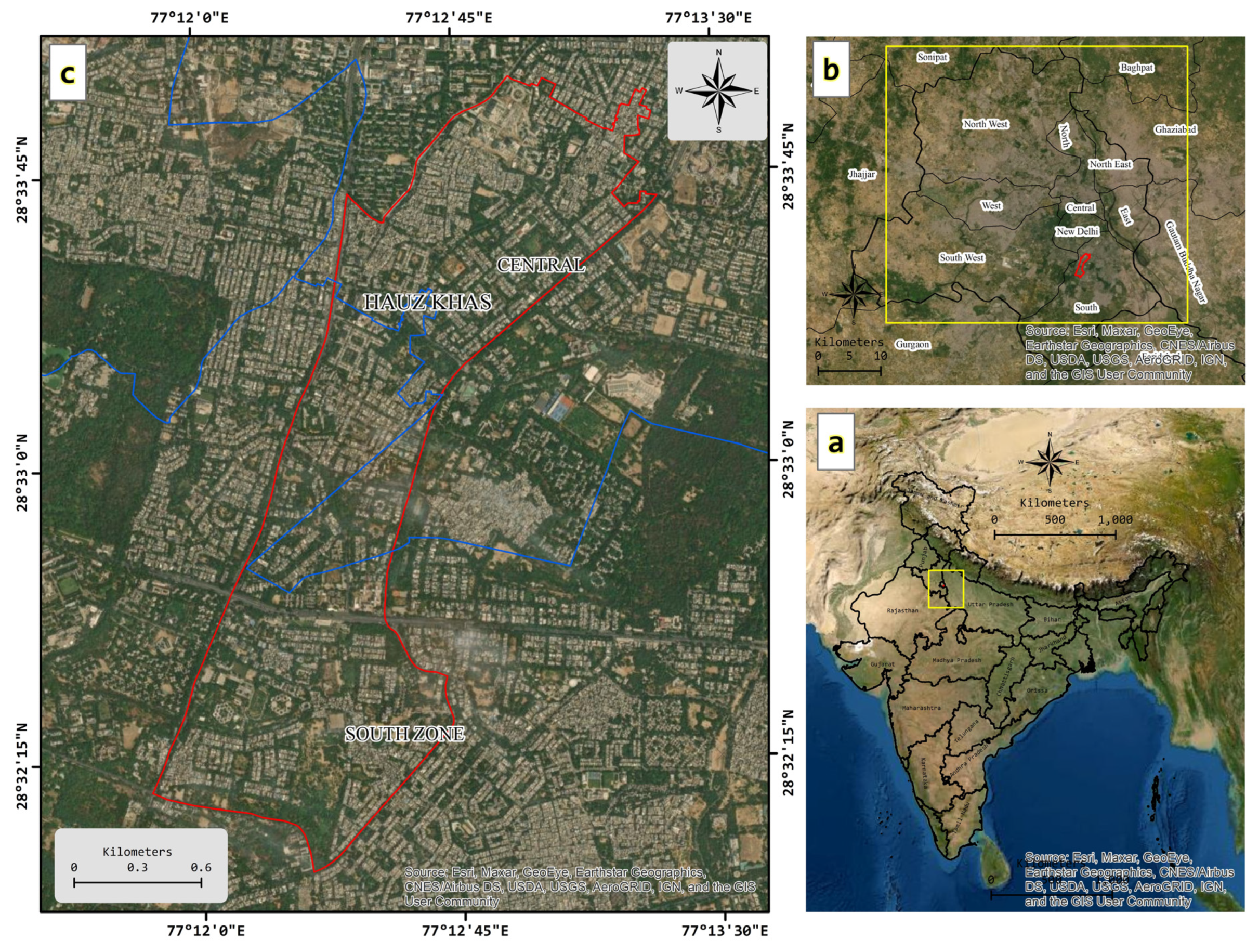
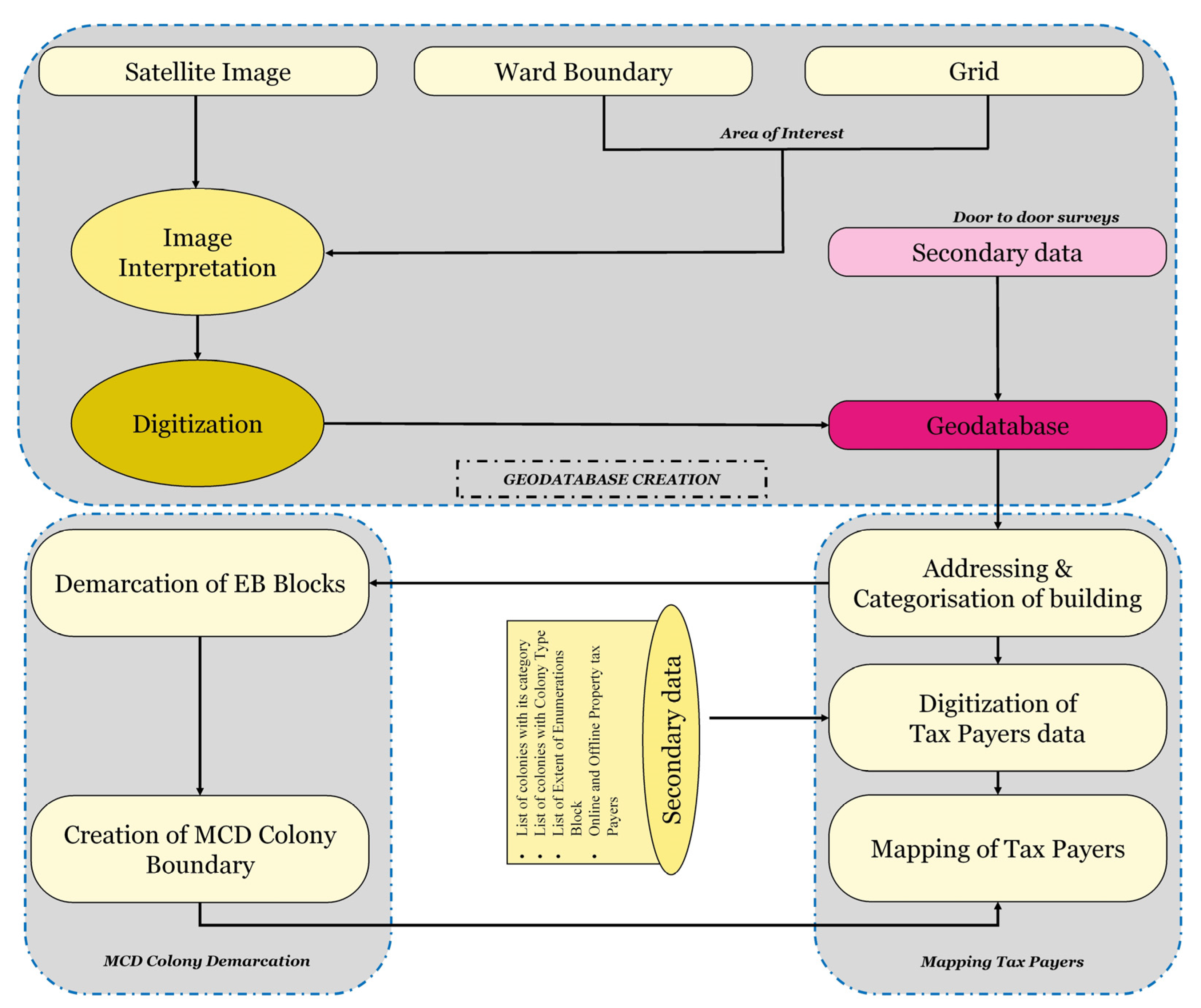
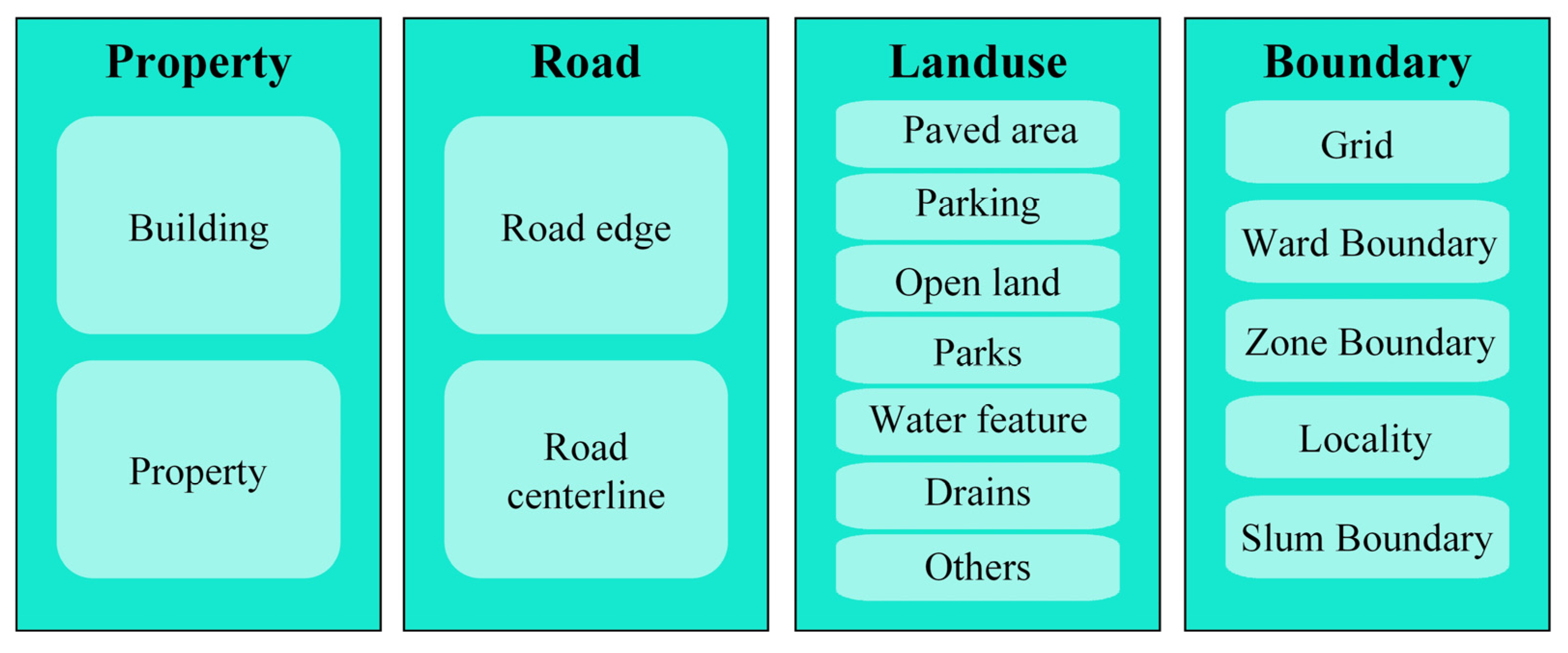
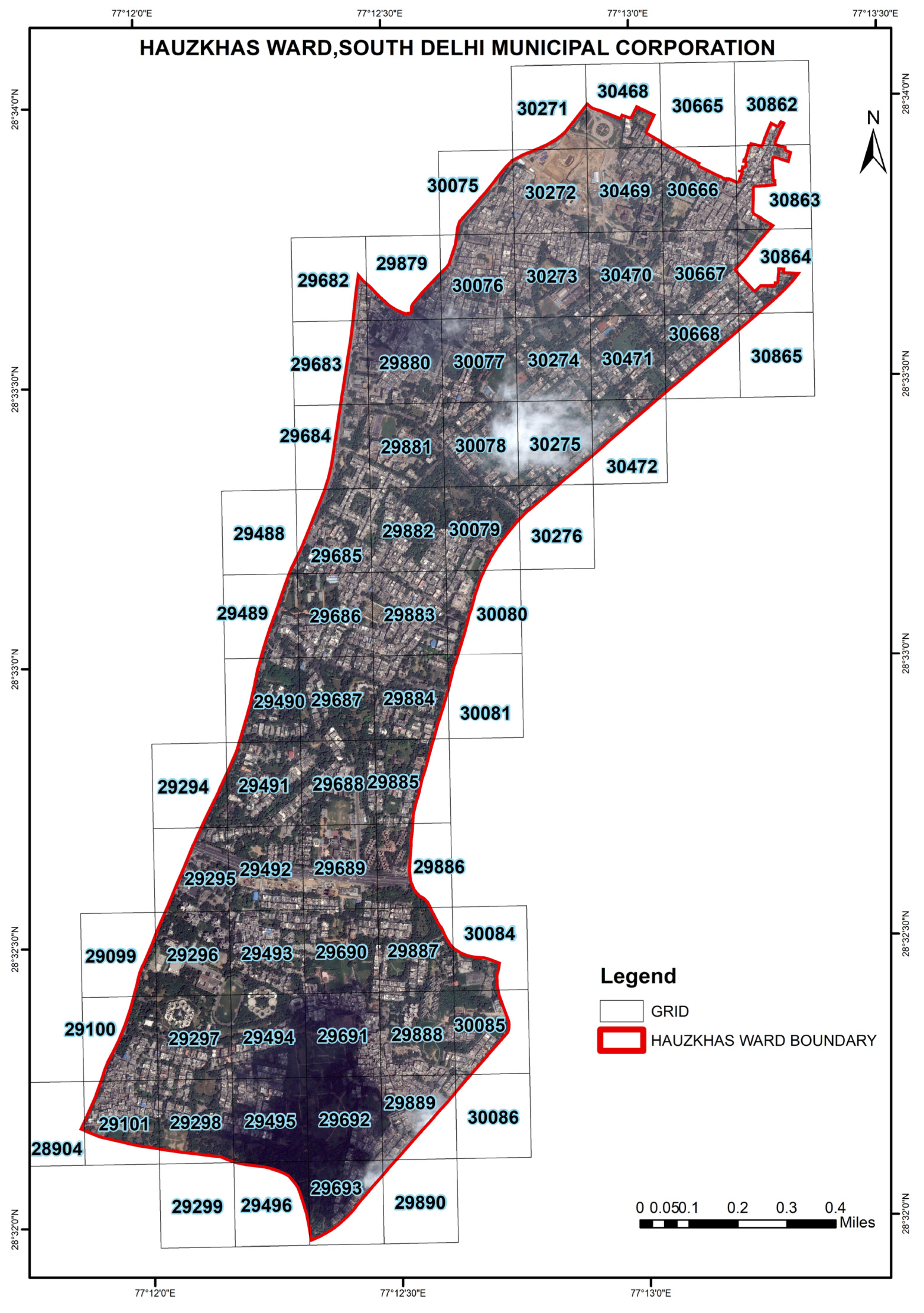
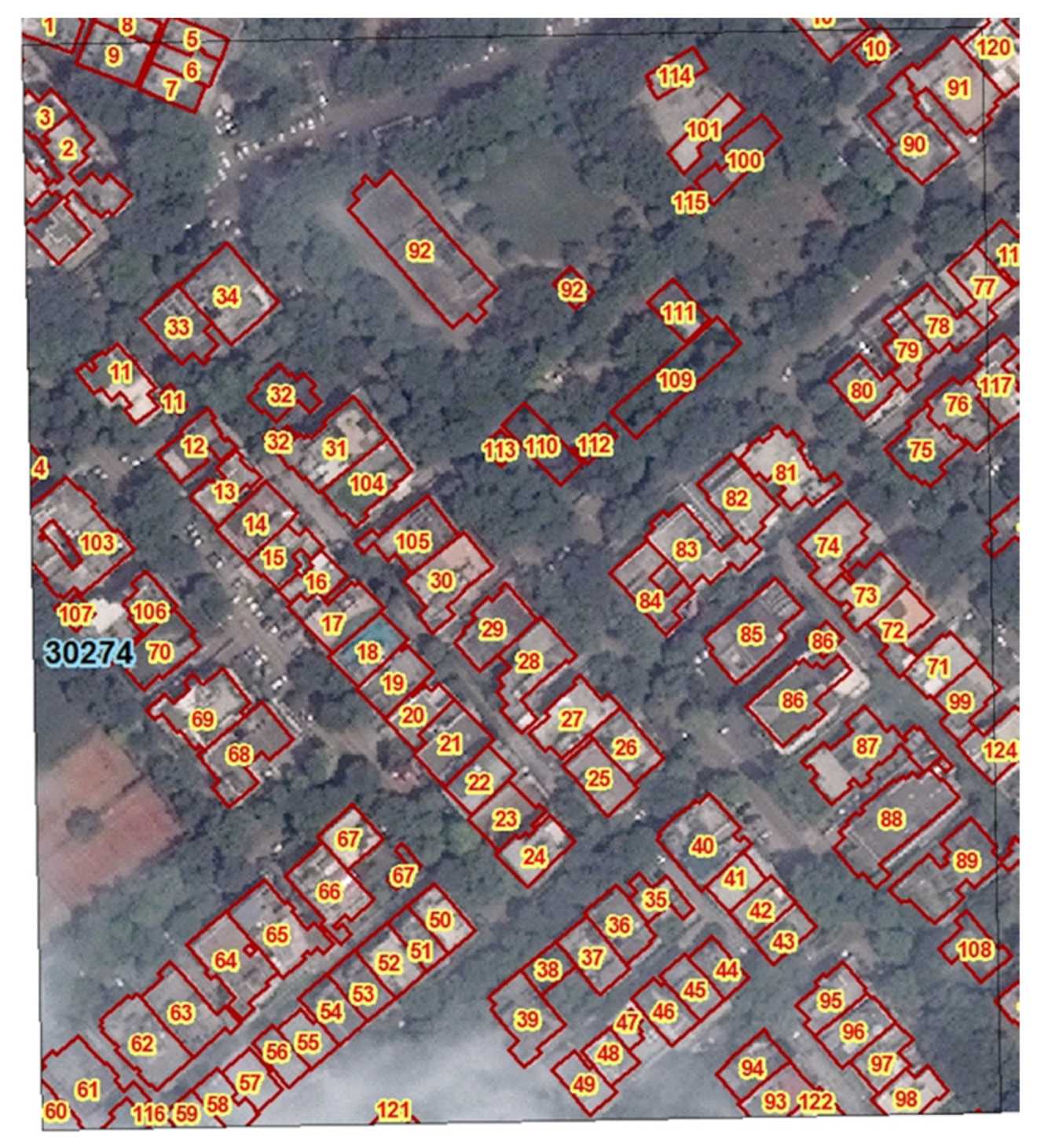
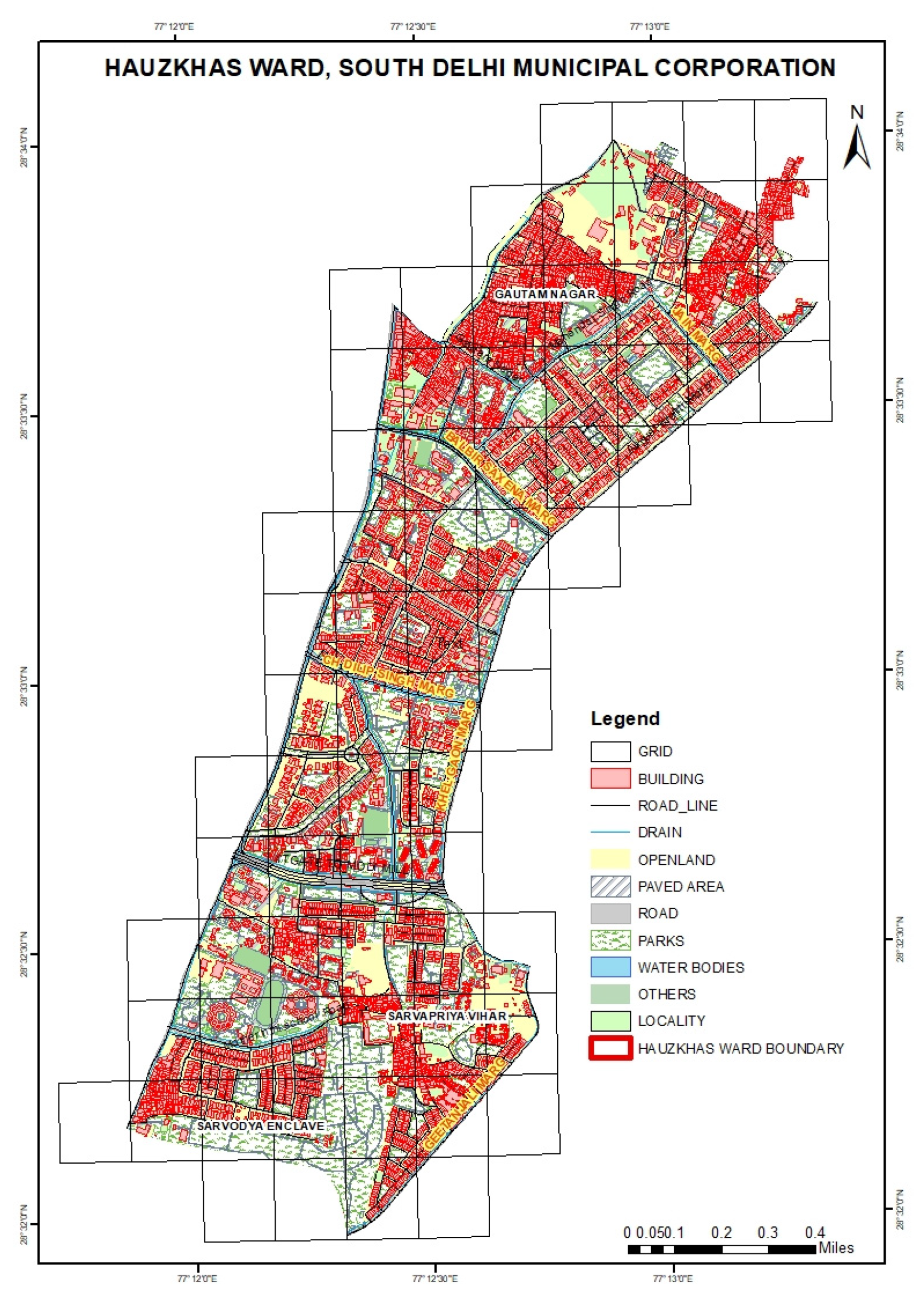

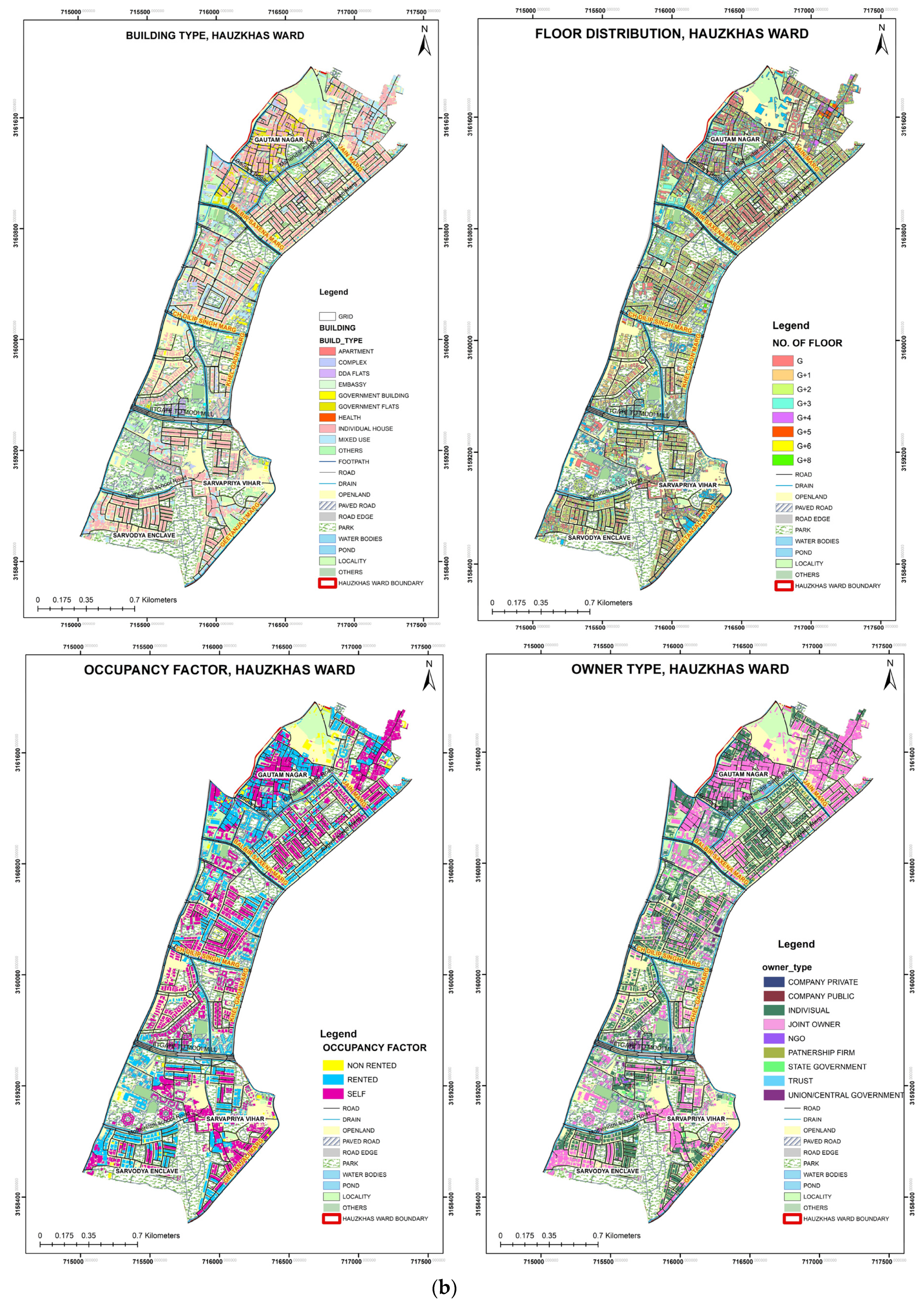
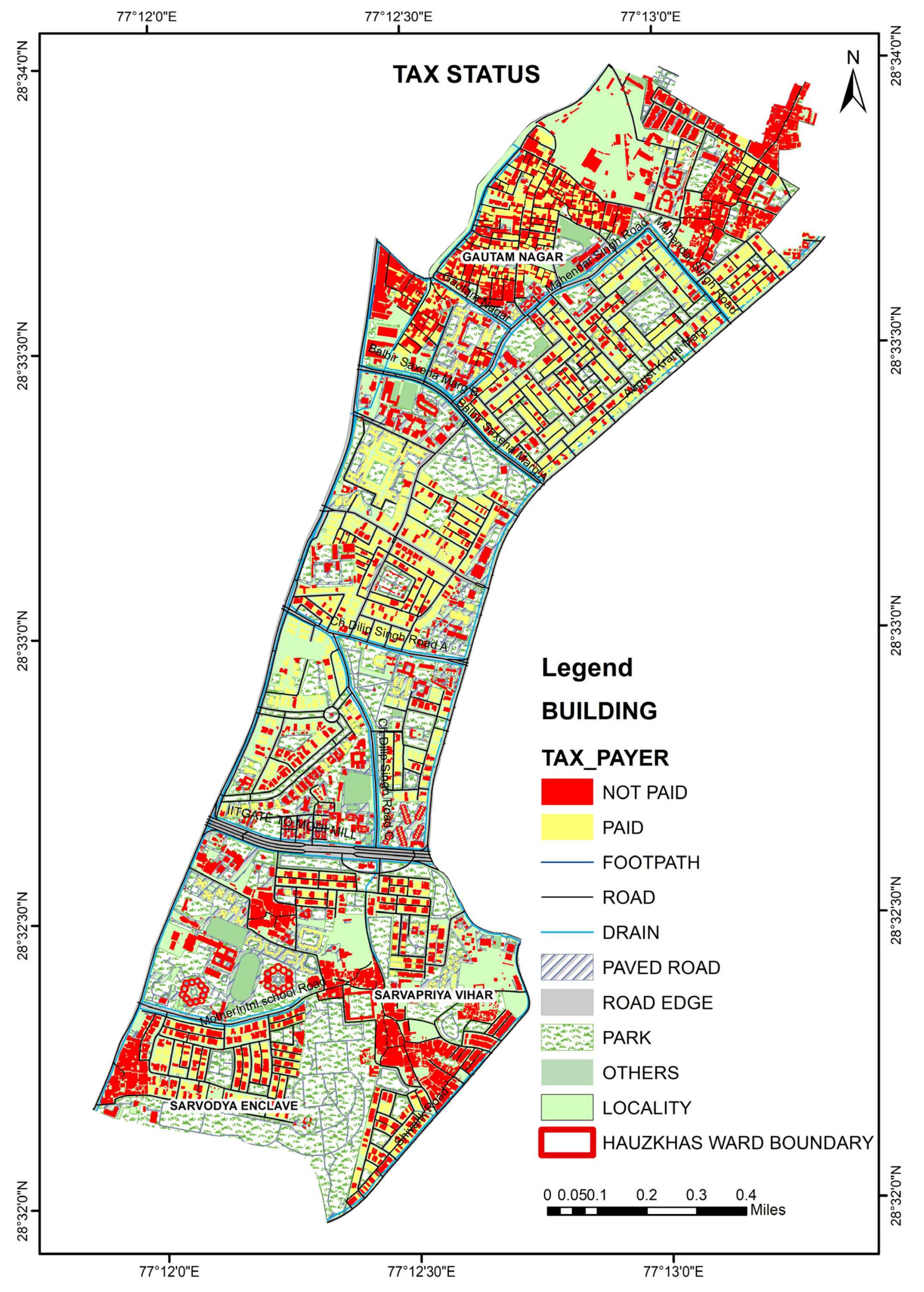
| Map Number | Building Reference Number | Building ID | BUID |
|---|---|---|---|
| 30274 | 1 | 00001 | 3027400001 |
| 30274 | 2 | 00002 | 3027400002 |
| 30274 | 81 | 00081 | 3027400081 |
| 30274 | 82 | 00082 | 3027400082 |
| 30274 | 112 | 00112 | 3027400112 |
| 30274 | 113 | 00113 | 3027400113 |
| Land Use | Area (m2) | Percentage |
|---|---|---|
| Water Body | 0.02 | 0.005 |
| Building | 92.57 | 29.50 |
| Open land | 72.36 | 23.06 |
| Others | 12.11 | 3.86 |
| Park | 72.48 | 23.09 |
| Paved Area | 26.87 | 8.56 |
| Road Edge | 37.45 | 11.93 |
| Category | Residential Property | Commercial Property | Industrial Property |
|---|---|---|---|
| A | 12% | 20% | 15% |
| B | 12% | 20% | 15% |
| C | 11% | 20% | 12% |
| D | 11% | 20% | 12% |
| E | 11% | 20% | 12% |
| F | 7% | 20% | 10% |
| G | 7% | 20% | 10% |
| H | 7% | 20% | 10% |
Publisher’s Note: MDPI stays neutral with regard to jurisdictional claims in published maps and institutional affiliations. |
© 2022 by the authors. Licensee MDPI, Basel, Switzerland. This article is an open access article distributed under the terms and conditions of the Creative Commons Attribution (CC BY) license (https://creativecommons.org/licenses/by/4.0/).
Share and Cite
Singh, A.; Singh, S.K.; Meraj, G.; Kanga, S.; Farooq, M.; Kranjčić, N.; Đurin, B.; Sudhanshu. Designing Geographic Information System Based Property Tax Assessment in India. Smart Cities 2022, 5, 364-381. https://doi.org/10.3390/smartcities5010021
Singh A, Singh SK, Meraj G, Kanga S, Farooq M, Kranjčić N, Đurin B, Sudhanshu. Designing Geographic Information System Based Property Tax Assessment in India. Smart Cities. 2022; 5(1):364-381. https://doi.org/10.3390/smartcities5010021
Chicago/Turabian StyleSingh, Anu, Suraj Kumar Singh, Gowhar Meraj, Shruti Kanga, Majid Farooq, Nikola Kranjčić, Bojan Đurin, and Sudhanshu. 2022. "Designing Geographic Information System Based Property Tax Assessment in India" Smart Cities 5, no. 1: 364-381. https://doi.org/10.3390/smartcities5010021
APA StyleSingh, A., Singh, S. K., Meraj, G., Kanga, S., Farooq, M., Kranjčić, N., Đurin, B., & Sudhanshu. (2022). Designing Geographic Information System Based Property Tax Assessment in India. Smart Cities, 5(1), 364-381. https://doi.org/10.3390/smartcities5010021












